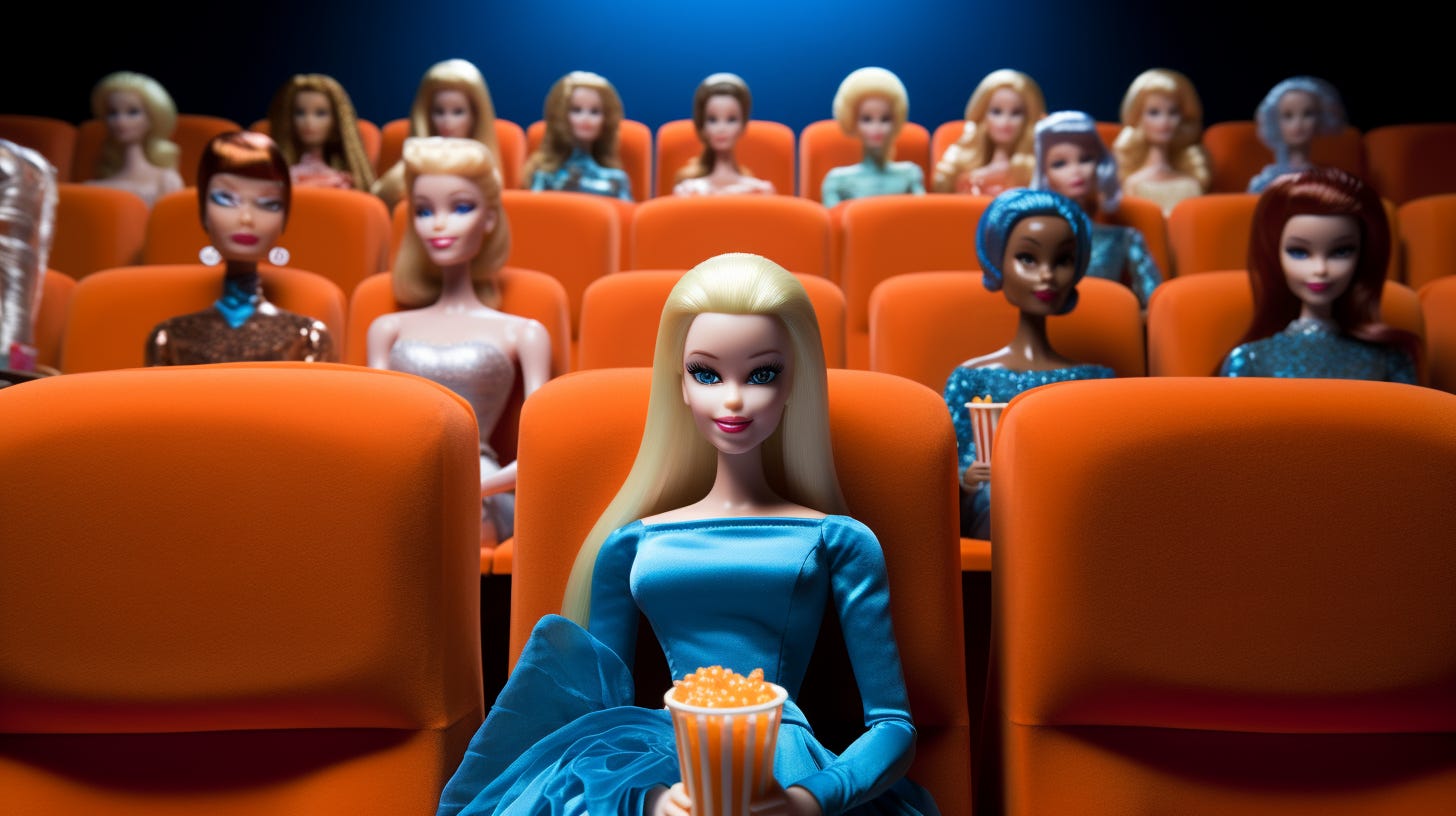Nostalgia & Fauxstalgia Marketing
Brands aim for the nostalgia nerve at their own risk but the Barbie movie's aim was true. Also Digital Marketing News: AI, Consumer Behavior, Content Marketing, Search, Social Media & Music Monday!

Fast Company - ‘Fauxstalgic’ branding is having a moment - We’re increasingly seeing brands move beyond nostalgia into the realm of “fauxstalgia,” engendering a strange sense of reminiscence for times, places, and events we’ve never even experienced by covertly implanting a kind of branded false memory…Brands have tried to harness the potency of nostalgia for as long as commercial branding itself. There’s a lot to be said for the power of reminiscing about the “good old days” to sell us stuff. Today, nostalgia is a balm for an increasingly anxious public that is concerned with the political climate, the actual climate, and everything from social to economic issues. Doom scrolling and today’s 24/7 news cycle (fake or otherwise) only serve to amplify this more than ever.
The irony here is that the very stress and anxiety the current political climate evokes was ushered in under the menacing banner of MAGA, a nostalgic declaration of white male power at any cost.
It is this dark nostalgia that is the source of the fear coursing through American society. That fear helps explain that massive popularity of superhero movies: We yearn for someone to come save the day.
That doesn’t dismiss the point of the article, however. I agree that the incorporation of nostalgia by brands is a reaction to public anxiety. It can be a powerful marketing tactic.
Kowalski’s, a local grocery chain here in Minnesota, has been celebrating its 40th anniversary by digging into the company archives and sharing content from its past on social media.
A recent Facebook post simply featured a black and white photo of a store sign sporting the chain’s since-retired “Red Owl” logo. As of this writing, that post has generated 1,509 likes, 173 comments and 104 shares.
It hit a nostalgic nerve for me. There was a Red Owl grocery store my family used to shop at and which we passed every Sunday on our way to church. My mother had worked there as an accountant for a time. I never made the connection that Red Owl was actually called Kowalski’s. We always just called it Red Owl.
Clearly, I was not the only one for whom the nostalgia worked. Check out the engagement the post received:
It’s one thing to revisit a style or fashion of a bygone era to evoke nostalgia for people who actually lived through that era or to create a “fresh” look for those who did not. It is another thing entirely to effectively match the zeitgeist of a bygone era with the emotion you intend to evoke.
Paid Subscribers: Watch for a new segment of Chapter Two to drop on Wednesday. It will address color psychology and its application to website design.
Without adequate research and thought, brands run the risk of unintentionally evoking the opposite emotions of what they originally envisioned.
The insane popularity of the Barbie movie is an example of flawless execution of a nostalgic commercial. (And let’s face it, the movie was nothing if it was not a two-hour long commercial for Mattel.)
Director Greta Gerwig skillfully navigated the 60s-era doll and its attendant criticisms of promoting an unrealistic body image for young girls and the fact that it took ten years before Mattel sold a doll that was not white.
The stage is set from the opening scene with both an homage to Stanley Kubrick’s 2001: A Space Odyssey and a nod to the idea that we all evolve…and by extension, Barbie does too.
The movie taps into nostalgia for three generations: Grandparents, mothers and daughters.
Impressively, the movie is simultaneously a take-down of patriarchy, about female empowerment, and also an incisive examination of male psychology. I mean, that’s really why the outrage industry is wailing about it: The movie exposes male insecurities for all to see.
$1 billion in box office receipts doesn’t lie.
Here’s the first-ever Barbie commercial:
And here’s the movie trailer:
Get Premium Access To The Reputation Algorithm By Referring Friends Or Colleagues
Show your support by sharing The Reputation Algorithm and earn rewards for your referrals. Start Now.
Digital Marketing News
Artificial Intelligence
VentureBeat - Stability AI unveils new FreeWilly language models trained using minimal — and highly synthetic — data - An open-access paper described a process of “model collapse,” wherein LLMs trained on increasing amounts of AI-generated data performed more poorly than predecessors trained on human-generated data.
However, when training the FreeWillys, Stability AI used two other LLMs to generate 500,000 examples and 100,000 synthetic examples, respectively, and found that the FreeWillys still performed well, showing that synthetic data may be an answer to model collapse — and to avoiding the use of copyrighted or proprietary data.
This is promising if it holds.
Ars Technica - A jargon-free explanation of how AI large language models work - If you know anything about this subject, you’ve probably heard that LLMs are trained to “predict the next word” and that they require huge amounts of text to do this. But that tends to be where the explanation stops. The details of how they predict the next word is often treated as a deep mystery.
One reason for this is the unusual way these systems were developed. Conventional software is created by human programmers, who give computers explicit, step-by-step instructions. By contrast, ChatGPT is built on a neural network that was trained using billions of words of ordinary language.
As a result, no one on Earth fully understands the inner workings of LLMs. Researchers are working to gain a better understanding, but this is a slow process that will take years—perhaps decades—to complete.
This is the best plain-English explanation I’ve yet read about how LLMs work. Highly recommend.
MIT Technology Review - AI language models are rife with political biases - Researchers conducted tests on 14 large language models and found that OpenAI’s ChatGPT and GPT-4 were the most left-wing libertarian, while Meta’s LLaMA was the most right-wing authoritarian…As AI language models are rolled out into products and services used by millions of people, understanding their underlying political assumptions and biases could not be more important. That’s because they have the potential to cause real harm. A chatbot offering health-care advice might refuse to offer advice on abortion or contraception, or a customer service bot might start spewing offensive nonsense.
Good to know.
Consumer Behavior
Neuroscience News - Stealing a Brain Hack: Exploration vs Urgency Shapes Memory and Learning - Researchers showed that when participants imagined themselves as art thieves scouting a virtual museum for a future heist, they had a better memory of the paintings they observed than those imagining executing an immediate heist.
This difference between exploratory and urgent mindsets could have implications for framing challenges such as vaccine promotion or climate action. The findings showed that the “curious” group, planning for the future, had superior recall, while the “urgent” group was more adept at discerning high-value items.
This reminds me of a memory hack I’ve used to remember poetry and I think is an example of the Exploration mindset described in the article. The memory hack is this: Imagine a familiar place such as your home. Then, imagine lines from the poem placed in that familiar environment so that you can see the lines of poetry as you walk through your home in your imagination. It worked for me.
Content Marketing
Search Engine Land - How to audit your YouTube channel for brand success - Views, subscribers, likes, comments and shares give a good feel for how your video content is performing.
But if you really want to get into the nitty-gritty, YouTube Analytics is a gold mine.
It tells you everything from watch time and traffic sources to audience demographics, with data for individual videos and the channel overall.
Understanding these numbers is crucial to know what is and isn’t working.
I’m constantly amazed at how under-utilized YouTube is as marketing channel. This article is a good primer on the metrics that determine the algorithmic reputation of your YouTube channel.
Search
TechCrunch - Google is making it easier to find and remove personal info, explicit images from Search - The search giant is going to roll out a new dashboard that will inform users if web results with their contact information is showing up on Search. The new dashboard builds on Google’s “Results about you” tool that launched last year and makes it easy to request the removal of search results that contain your phone number, home address or email. With this new dashboard, you can quickly request the removal of your contact information from Google.
Good step toward increasing safety.
Social Media
The Verge - BBC launches an ‘experimental’ Mastodon server - The BBC has launched its own “experimental” Mastodon server, marking one of the first major news outlets to establish an instance on the Twitter alternative. You can access the server at social.bbc, which encompasses posts from a handful of BBC accounts, including BBC Radio 4, BBC Taster, BBC Research & Development, and a few more.
The BBC says the outlet will try out the server for six months before it decides “whether and how to continue.” While you can’t actually create accounts or posts on the server, you can still leave replies from the instance that you’re using, as well as follow its accounts.
This is an interesting experiment to keep an eye on. Mastodon has some serious usability issues. But given how important social media has become to news distribution and disovery, if media outlets can figure out how to own their audiences on self-hosted social platforms like Mastodon rather than relying on leasing audiences from the major platforms, it might help bolster their brands and improve their operating models.
Social Media Today - New Analysis Reveals How X Is Evolving Its Feed Algorithm, and What It’s Looking To Emphasize - According to the code, X is now looking to amplify replies to posts, with replies to content now getting more exposure than even retweets in the main “For You” feed.
Replies are a key component of X’s ad revenue share strategy, with creators getting a share of the ad intake from ads shown in the reply stream. As such, it seems like X is trying to show more eligible ads, by highlighting more replies, which will ideally get even more people engaging in the same conversation, this expanding the potential for ad display.
So, suspending my skepticism of Twitter’s “ad revenue share” program for a moment, this just seems much more likely to encourage the proliferation of the bots Musk was so obsessed with eliminating at the outset.
Whatever. I’m done with Twitter. My tolerance ends where fascism begins.
TechCrunch - YouTube is disabling links on Shorts to cut down on spam - YouTube Shorts is making a change to address the growing issues around spam on the short-form video platform. The company says that starting on August 31st, links that appear in the Shorts comments section, Shorts descriptions, and the vertical live feed will no longer be clickable. This new policy is meant to be a preventative measure that makes it harder for scammers and spammers to mislead and scam users via links.
I’ve no doubt that link spam is a problem on YouTube Shorts but how convenient that this policy helps to increase YouTube’s (and other social media platforms’) desire to keep visitors on platform rather than letting them leave via links.
There’s a reason Watch Time is the primary metric for visibility within YouTube.
Music Monday
Glad to hear new Peter Gabriel music and the animation on this music video is amazing!
Glorious Midjourney Mistakes
Here are some of the images that didn’t make the cut for this week’s newsletter.











